
I'm going to change pace a little bit for this installment of "How Madden Fails To Simulate Football". Previously, I've focused on the rules of the game and on on-field gameplay. This time, I'm going to go off the field and start talking about team-building and coaching strategies, which are key to creating an engaging Franchise Mode experience.

This is a topic that was voted upon by my Patrons. If you would like to have voting power to influence the content that I create, then I encourage you to support my content creation through Patreon. Patron support helps offsets the cost of the server for my blog, the license for the software that I use to YouTube edit videos, and any research material that I buy.
The COVID years have been hard on a lot of people, and many of my Patrons had to discontinue their support due to financial hardships. I want to take a moment to wish all my former Patrons the best. I hope that 2022 treated you better, and that 2023 will be better yet. I'd also like to thank my current Patrons and those who stuck with me. To all my Patrons -- past, present, and future -- thank you for your support.
Now let's talk football! I'm writing drafted this essay in the month or 2 leading up to the 2023 NFL Draft, so this topic will actually be kind of relevant at the time that it is published.
The full video on YouTube contains additional commentary and examples.
One of the ways that Madden is most different from real life football is that in Madden, the exact skill level of every player in the league is known to everyone all the time. Because of the way that Madden implements player attributes and progression, users don't have to evaluate player talent at all. Ever. In the vast majority of cases, ordering your depth chart is a simple matter of sorting the players by their overall ratings. And if it's not the overall rating, then there's usually a single other attribute rating that determines who starts and who doesn't. It's usually speed. For example, I favor kick and punt returners with speed, and usually put my fastest reserve player as my starting returner, regardless of his overall rating. So yes, there are some edge cases where a user gets to make judgement calls about which player better fits your play style. But for the most part, it's all about that overall rating.
This means that there is no mystery or question about which players are actually good, which players aren't so good, and which players are outright busts. It also means that Madden doesn't have true position battles. One player is objectively better than the other in the vast, overwhelming majority of cases, even if it is just marginally so. It means there's no question whether a free agent or trade will be an upgrade over the players already on your roster. It means that there isn't much value in testing out rookies in the preseason because you already know exactly how good those players are, and whether they are deserving of a starting position or roster spot based on their overall rating.
All of the intrigue and "what ifs" that go into roster movements and decisions in NFL front offices are simply non-existent in Madden because so much of the game is based on these absolute numbers that are completely open and transparent to everybody.
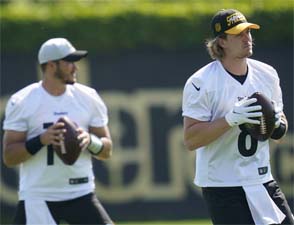 photo credit: Pittsburgh Post Gazette
photo credit: Pittsburgh Post Gazette
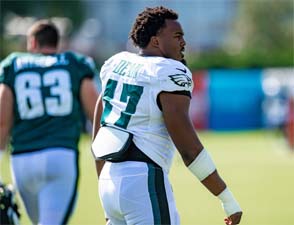 photo credit: John Jones / Icon Sportswire
photo credit: John Jones / Icon Sportswire
Every year, there are questions about who is the best player in many teams' lineups.
Think of some of the big questions from early in the 2022 season: Will Kenny Pickett play as well or better than Mitch Trubisky on week 1? If not, how long should Pickett sit behind Trubisky? Should Devin Singletary get more carries than James Cook? How about Tony Pollard or Ezekiel Elliot? Should the Packers look to Allen Lazard or Sammy Watkins to replace the lost productivity of Devante Adams? Will Nakobe Dean play well enough as a rookie linebacker, or should the Eagles stick with their veteran starter from last year? Is Mac Jones a lost cause, and the Patriots should switch to Bailey Zappe? Should Trey Lance sit behind Jimmy Garoppolo?
And hell, who would have thought that Brock Purdy, the dead last selection in the 2022 draft, would turn out to be so good? I'll tell you, the Madden ratings adjusters at EA and Tiburon sure as hell didn't think it! When the 49ers lost both Trey Lance and Jimmy Garoppolo to injury, they were left with a decision to either play that 3rd string rookie Mr. Irrelevant, or go look for a veteran free agent. They chose to gamble on Purdy. But in Madden, this is no gamble at all. Just look at his ratings, and that will tell you if you need a veteran free agent or not.
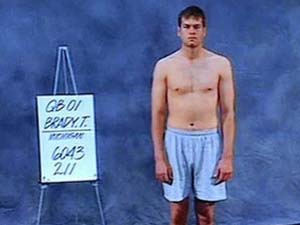 photo credit: NFL
photo credit: NFL
Nobody knew Tom Brady would be the G.O.A.T.
when he was drafted in the 6th round.
Hell, Tom Brady was a sixth-round draft pick, who, if not for an injury to Drew Bledsoe, may never have been anything more than a journeyman backup! Sigh ... if only...
To its credit, Madden does try to provide some optional tools for customizing the user's experience, and some of them can actually be used to mitigate some of these roster and depth-chart problems. For example, I like to set my Fatigue and Injury sliders higher than default in Franchise Mode, and I also raise the auto-sub threshold for many positions. This adds some value to playing reserves in rotational or situational positions like 3rd down running back, pass rushers, or sub linebackers because the starting running back, defensive linemen, and linebackers will be more likely to be fatigued when these situations come up, and so might not be playing to their fullest potential. This creates some extra wiggle room for assigning players to these situational positions who aren't base starters.
But this only goes so far, and CPU teams don't really have very sound substitution strategies. They just put the best player at the top of the depth chart at every position, and only sub them out if they are actually below the auto-sub fatigue threshold.
How Madden Fails At Preseason
The complete transparency of player attributes in Madden has traditionally had the effect of making the off-season feel largely un-interesting, and the preseason is almost completely pointless. Madden users don't use the preseason in the same way that a real NFL coach would use the preseason: which is usually 3-fold:
- to shake out any rust in the veteran starters,
- to determine how good their rookies, trades, and free agent acquisitions fit into their scheme,
- and to develop those younger players' skills with actual full-speed game experience against a real opponent.
Only the last bit is relevant in Madden, since the other 2 reasons for the existence of preseason are rendered moot by the fact that Madden just tells the user how good each player is, and whether they fit your chosen scheme. And even then, that last bit has only become relevant in Madden in the last console generation, with the introduction of the player experience system.
Preseason is more important due to the experience system implemented in the current generation of Madden.
I would be willing to bet that most Madden users don't care much for the preseason, and probably skip it in their Franchises. This is partly because most users probably don't think the preseason is "meaningful football" and don't see much value in playing it. It's probably also due in large part to the fact that Madden has historically failed to provide any mechanics or systems to make the preseason worth playing.
But I think the preseason is an under-rated part of the current generation of Madden games, and a part of the game that more players should play. And if you've already seen my essay on "I actually like the Preseason of Madden", then you know where I'm going with this.
One of the biggest successes of the modern incarnations of Madden's Franchise Mode is that it has actually introduced mechanics and systems that have made the preseason more interesting and meaningful -- at least with regard to developing young players. The biggest new mechanic, which was introduced in 2016 or 2017, is the Practice Squad. In older Madden's, when it came time to cut down to 53 players, those cut players would just disappear into the free agency pool, where they would stagnate. Another big change is the move from stat-based, end-of-season ratings progression towards a more RPG-like experience and level-up mechanic. Players gain experience from practice and from playing in games, and breakout performances can grant large, immediate attribute ratings boosts.
Giving a rookie or practice squad player lots of extra reps in the preseason can be a good way to give him experience and potentially level up some of his skills. Even if he won't end up in your 53-man roster right now, he can be stashed on the practice squad for a couple years until he does level up enough that he's a viable starter or backup. And even if he never pans out, giving him a couple extra points to his overall rating will increase his trade value if you decide to dump him off for a better player or some extra late-round draft picks.
Practice Squad and hidden dev traits make preseason more worthwhile to play.
The last new design element that makes preseason more worthwhile is that some players have "hidden development traits", which require the player to play a certain number of snaps in a live game before the trait is unlocked. This is the one and only place in which a characteristic of a player is hidden to the user unless you play the player on the field. And you have to play that player quite a bit. You don't just put him in for one quarter of a preseason game and suddenly know how good he is. He'll have to see plenty of playing time in the regular season too. This means that playing a lower-rated player over a slightly higher-rated player might be beneficial because it unlocks that hidden dev trait sooner. And preseason provides a perfect opportunity to get some extra reps for such players and unlock those hidden dev traits a little bit sooner.
Madden 23 also introduced player tags. These don't have much of an impact on player talent evaluation, but they do give the user something else to consider when building a roster, and have the potential to give some value to certain players beyond just their overall rating. I've found the "Mentor" tag, in particular, to be very valuable. I will sign low-rated veteran mentors as backups behind my young, developmental players and draft picks.
These design elements of preseason give the user more judgement calls to make, and encourage a little bit of experimentation and creative play-calling. I wish that Madden would take these ideas a step further, and extend them to the entire season. And I wish that the CPU would be programmed to have to play its own reserve players in order to figure out how good they actually are. And if you're not going to program the CPU to sub deeper into its roster for preseason games, Tiburon, then at least let the user alter the CPU's depth chart for preseason games, so that I can actually play my 3rd and 4th stringers against the CPU's 3rd and 4th stringers, instead of having to play against the CPU's starters and 2nd stringers.
The CPU won't sub deeper into its roster late in the preseason, nor can the user modify the CPU depth chart.
The right player for the right job
If you aren't just simming the whole preseason, you might play around with some deep reserves in preseason. Maybe. But once you get into the regular season, those players are either cut, or stashed on the practice squad. The rest of your lineup at that point is pretty much set in stone. And unless some young player had a breakout preseason and gained a few points to his overall rating to put his overall at or above the guy at the bottom of your depth chart, your starting lineup after the end of preseason probably looks almost exactly the way it did at the start of preseason. It all just comes down to the numbers, and those numbers just aren't going to change that much in just 3 games. Especially if the younger reserves are only seeing 1 quarter (or less) of action in each of those 3 games.
Although it's possible to get a "bust" in the draft, there is just no concept of a "bust" when it comes to free agent or trade acquisitions. You're not going to find out that a particular trade or free-agent pick-up is simply not working out. You're not going to acquire a player thinking that he's an 80-overall, only to find out from preseason play that he's really only a low-70-something who just doesn't fit your scheme or play-calling style. You know exactly what you are getting!
Oh, and while we're on the topic of the Draft in Madden, I have a nagging pet peeve that I want to get off my chest. When Madden projects when a rookie will be drafted, it lists the round number for rounds 1-3, but then for rounds 4-7, it changes to say "Day 3". Why not just say "Rounds 4-7" and stay consistent with your language? In fact, Madden doesn't split the draft up into multiple days the way that the real NFL Draft is structured. In Madden, the Draft goes through all 7 rounds without stopping. I could easily see a casual football fan or Madden player, who doesn't pay much attention to football in the off-season, not really understanding what "Day 3" even means. Does that mean "Round 3"?
Madden should split its draft into multiple "days" and provide recaps and projections for each day.
Either change this projection to say "Rounds 4-7", or split your draft into multiple "days". Maybe Madden's Draft should stop after the first round. It could then show a summary of the 1st round's picks, maybe have a fancy analysis show to talk about which teams made good picks and make some new projections about which teams might draft which players in the 2nd round. It could then give the user a little bit extra time to look through the remaining draft prospects, re-organize your draft board, and maybe do some wheeling and dealing to trade picks around. Then start round 2, go through round 3, and then stop again for another draft summary, some more analysis, another set of projections for which teams might draft which players in round 4, and another opportunity to look at who's left and re-organize your draft board. This way, the phrase "Day 3" is actually meaningful within the video game.
Madden also doesn't really have any concept of a player simply not being suited to a particular role. Yes, modern Madden does have concepts of "scheme fits", but these don't really affect the player's play on the field. Basically, each scheme has a set of preferred attribute ratings, and if that set of attributes happens to be (on average) higher than the sets of ratings preferred by the other schemes, then the player is considered a "fit" for that scheme. His overall will show up as a little bit higher for teams that run a scheme for which the player "fits", so different teams might actually see slightly different overall ratings for any given player.
But again, you know if the player is a scheme fit because the ratings are all known, publicly-available values. You're not going to trade for a particular player, thinking that he'll fit your scheme well, only to find out that he just doesn't.
You know for sure if a player is a good fit for your chosen scheme.
It doesn't help that players in Madden have generally lacked any kind of personality. I've also covered this topic a bit in my video on the "Humanity of NCAA Football's Recruiting". Madden 23 tried to rectify this somewhat by giving all players a set of motivations. But these only go so far. They only affect how much money a player will be willing to accept from a given team in order to sign in free agency. As far as I can tell, being with a team that doesn't fit a player's desires does not reduce that player's morale or his performance on the field. Players don't hold out for a better contract or complain about their role with the team during press conferences. And they certainly don't become locker room distractions that negatively impact the team's on-field performance.
There's also no pressure on coaches to play or bench particular players. If Mitch Trubisky throws a 3rd interception in the first half, nobody is going to start calling for Trubisky to get benched and for Kenny Pickett to start the second half. If a backup like Bailey Zappe plays well in relief of a struggling starter like Mac Jones, there won't be a "QB Controversey" among the fanbase, media, or locker room. There's also no pressure from fans, players, or bean-counting management to play an over-paid veteran in order to get your money's worth from him, even if he isn't the best player on the depth chart.
As Brett Kollmann points out in his video about the 2020 Cardinals defense turning itself around in the middle of the year, Defensive coordinator Vance Joseph may have felt pressured to play an over-paid veteran, Terrell Suggs, in the twilight of his career even though he simply didn't fit very well in the scheme. He was forced to adjust his depth chart around Terrell Suggs early in the season, which meant putting Haason Reddick in a position that was outside of his skill set. The defense struggled until Suggs was cut late in the season, which allowed the coaches to re-arrange their depth chart and put the right players into the right positions. In Madden, it doesn't matter how how much a player is getting paid or how popular he is among the fan base, or how storied his career has been, if he isn't the highest-rated player on the depth chart, he doesn't start.
Brett Kollmann has a video about how the 2020 were playing defensive players in the wrong positions.
Similarly, there's no question whether an offensive lineman is best suited to play interior line or at tackle, or whether he's better as a right tackle or left tackle. Heck, because quarterbacks can see the entire field, there isn't even much (if any) difference between the blindside offensive tackle and the other offensive tackle.
We often see NFL teams move offensive lineman around to different positions on the line. For example, in 2021, the Bears drafted Teven Jenkins in the second round as a stand-out right tackle out of college. He played his first NFL games at left tackle. But after inconsistent play at left tackle, he was moved the following season to right guard. He's been playing right guard ever since, and has been playing well in that position.
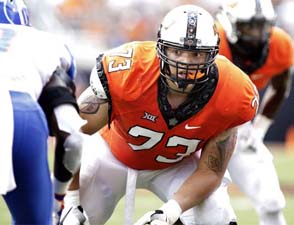 photo credit: Brett Deering / Getty Images
photo credit: Brett Deering / Getty Images
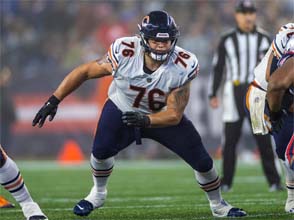 photo credit: The Athletic
photo credit: The Athletic
The Bears drafted Tevin Jenkins as a Right Tackle out of college, played him at Left Tackle his rookie year,
then moved him to Right Guard, where he has had his best performances as a pro.
We also saw the 2022 Raiders bench Derek Carr for Jared Stidham after they were eliminated from playoff contention presumably because they knew they didn't want to re-sign Carr, and they wanted to find out if Stidham was a viable starting quarterback. They eventually cut Carr altogether. And they apparently didn't like Stidham either, because they also cut him and signed Jimmy Garoppolo. Teams don't do this in Madden; they don't bench starters late in a lame duck season in order to test out backups and see if they are viable replacements. There's no chance that a 60 overall player (like Stidham) is going to perform better than an 80 overall player (like Carr), so the CPU will never bench a starter in favor of a lower-rated player, no matter how bad the starter's play is, no matter how young or un-tested the lower-rated player might be, no matter how dismal their season is going with the current lineup.
A human user might do something like this in order to give the backups experience and hopefully level up their ratings a little bit, but there's no expectation that replacing the starter for a lower-rated backup will somehow turn the season around. CPU teams could be programmed to play backups in a lame duck season in the hopes of improving their ratings too. That could at least create some of these realistic and interesting scenarios. But they don't. They stick with their starters to the bitter end.
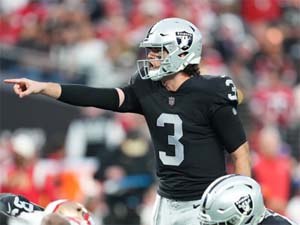 photo credit: Chris Under / Getty Images
photo credit: Chris Under / Getty Images
The Raiders benched Derek Carr in 2022
to test Jarett Stidham's staring viability.
These sorts of things simply don't happen in Madden. Knowing exactly how well a player will perform means there is virtually no ludic pressure to make roster moves during the season. If you've ever been playing a Franchise in Madden, and the trade deadline comes and goes without you noticing, this is probably a big reason why.
This wasn't always the case. Madden 06 had a Franchise mode built entirely around the idea of off-field drama. It included a Storyline Central feature that included newspapers and the Tony Bruno Radio Show that would routinely highlight locker room drama, contract negotiations, trade rumors, and so forth. I don't think it was nearly as robust as some people seem to remember it being, but it at least made the league feel more alive, and it forced Tiburon to program CPU teams to occasionally make roster moves just so that Storyline Central would have something to talk about. Even the NCAA Football games of that era included off-field drama, such as academic eligibility and off-field discipline problems such as players not showing up to practices.
Some have suggested that the NFL and NCAA might respectively be the reason for the disappearance of those features, as both organizations might have pressured EA to remove such features because they painted the leagues in a negative light. Given all the shady stuff that the NFL has been caught doing over the years, I wouldn't put this past the NFL.
EA's football games circa 2005 were built largely around off-field drama.
But it could also simply have been a matter of the code and assets being lost when Tiburon transitioned the games from PS2/XBox engines to PS3/XBox 360 engines. Or the features could simply have been removed due to a change in creative vision within the studio. I don't work at EA. I have no inside knowledge of the situation. I can't tell you which story is true. Maybe it's a combination. All I can say is that these features used to be in the game, so this is absolutely possible to implement from both a practical engineering and a gameplay design standpoint. There's no reason why modern, more advanced consoles and PCs should not be able to handle this sort of concept.
In fact, not only would such mechanics be possible, but they would actually fit in very well with the other existing features in Madden's Franchise. The current game already has morale ratings for players. It has the aforementioned experience and leveling system, with the possibility of breakout performances. It has little press conference mini-games. It has the concept of scheme fits and specialized roles. And it has these new tag and motivations features that could be used to help define a player's personality and priorities. And it has make-believe social media feeds and news headlines that are supposed to highlight the drama going around the league. But all of these features feel limp and weightless because they rarely -- if ever -- create truly dynamic scenarios, let alone interesting or difficult decisions for the user.
Modern Madden has fictional news and social media feeds, but rarely any stories for them to discuss.
What are the possible solutions?
So how can EA fix these weaknesses of Madden's Franchise Mode? Well, in terms of creating some off-field drama, all they need to do is look back at what the game was doing almost 20 years ago. And the other thing would be to take some of these ideas like Hidden Dev Traits, the practice squad, in-season scouting, player motivations, and player tags and extend them to their logical conclusions.
I've actually already pitched an idea for a solution to this problem in past blogs and videos. But I'm going to briefly summarize the idea here as well.
Basically, I believe that the actual ratings of young players should be hidden, and should be slowly revealed by practice, training camp, and play-time in actual games. Basically, take the in-season recruiting mechanic, which obfuscates incoming rookies' actual ratings prior to the draft, and extend that to each prospect's first few years in the league as well.
In fact, Madden already experimented a little with this idea all the way back in 2011. Madden 12 hid rookie ratings in the preseason, and a few ratings would be revealed each week of pre-season. This mechanic kind of sucked back in 2011 for various reasons, but I think it would work way better now, since it pairs better with features that have been introduced into Madden in the intervening years.
Madden 12 experimented with the idea of gradually revealing rookie ratings over the course of preseason.
For one thing, Madden 12 completely revealed all the players' ratings automatically over the course of the preseason, whether the player played a single down in preseason or not. So it wasn't based on that player actually playing or acquiring game experience, and it didn't incentivize users to play the preseason games in order to see their rookies in action. And only the ratings of rookies were hidden. By the end of preseason, all of the ratings of every player in the league were known.
Further, Madden 12 did not include any sort of practice squad, and it enforced the NFL's rule for mandatory cut days. Each week of preseason, the teams in Madden 12 had to cut players to meet a roster size that shrunk each week of preseason. This meant that very low-rated players would be cut without even having an opportunity to play in the preseason at all. And without a practice squad to move them to, those cut players would just vanish into the chafe of the free agent pool, where they would never progress.
Maybe it's time for modern Madden to take another stab at that old Madden 12 mechanic. A revision of this mechanic could be extended out to be a season-long process, such that player ratings are revealed gradually over time by weekly practice reps and by game reps. Practicing the player and playing him during preseason would reveal his ratings sooner than just practicing and playing starters. And if any player's full ratings are not revealed by the end of the preseason, we can stash him on the practice squad and continue to evaluate and develop him over multiple years, instead of having to just cut him.
Once the starters have been subbed out, CPU teams should sub deeper into their depth chart as the preseason game progresses. The CPU should focus on giving more play time to younger players with less experience whose skill ratings are mostly unknown.
Maybe ratings are slowly revealed automatically based on how much the player plays and practices. Or maybe, each time the player gains enough exp and levels up, some of his true ratings are revealed. And maybe there could be a Training Camp that allows each team to automatically reveal certain ratings for players. And there could also be coach abilities that could allow them to reveal extra ratings.
Longer player evaluation periods would pair nicely with the return of playable Training Camp mini-games.
This could also open the door to a playable training camp feature. Perhaps, after the off-season training camp, every player should be given a "Camp Grade" for each player, which indicates how well that player performed at camp. Users could have the option to personally play the drills with certain players and possibly progress them faster and reveal more of their ratings, but at the risk of also playing poorly and stunting that player's development. Players who perform very well at camp may get an experience boost when they get to the preseason and regular season, or trigger story events that give them goals which will grant huge experience boosts if met. This creates a mechanical incentive to give that player more playing time, even if it is just a rotational role. A backup may have a really good camp and earn himself a starting spot, but it should also be possible that a veteran starter has a mediocre camp, but still is skilled enough to retain his starting job.
If given the choice between a veteran with completely known ratings, and a younger player who might be slightly better, but his exact ratings are unknown, CPU teams should favor the established veteran as the starter going into the season, but give the younger player plenty of rotational reps. Eventually, as the younger player levels up and his ratings are revealed, he can be moved into the starting slot.
So in a case like the 2022 Pittsburg Steelers, they have mediocre Mitch Trubisky and inexperienced rookie Kenny Pickett as QB options. Pickett might be better overall, but the Steelers wouldn't necessarily know that. As such, they should err towards starting Trubisky until Pickett proves himself in actual play, or Trubisky blows it.
Veteran regression
Furthermore, player regression could be tweaked so that when an older player's ratings start to regress, those regressed ratings once again become hidden. This would mean that signing a veteran free agent (or re-signing a veteran whose contract has expired) might be a bit more of a gamble. Teams simply wouldn't know, for sure, if that player is still as good as he used to be.
This would also add more incentive to test out veteran free agent or trade acquisitions in the preseason in order to make sure that you didn't pay all that money for a veteran bust. And finding out in the middle of the season that a veteran's ratings have regressed more than you thought might create more pressure to trade that player. Maybe there can even be ways for the player's current team to reveal the regressed ratings prior to the rest of the league finding out about them, so that you can potentially try to sucker another team into trading for your regressed veteran, while that other team still thinks that the veteran has some gas left in the tank.
Regression should also hide some veteran player ratings.
Or maybe, revealing that a player's ratings have regressed could become grounds for re-structuring the player's contract so that you can free up some cap space to sign and start grooming a younger replacement. This could be especially viable if the veteran has the "Mentor" tag. Even if he physically isn't capable of playing his position at a high level, he could still be worth keeping on your roster for a year or 2 in order to teach younger players and progress them faster.
This could also affect a player's scheme fits. If you don't know his exact ratings, you might also not know if he's still a good scheme fit. For example, if an edge rusher has lost a few steps in speed, maybe he's not a great edge rusher anymore. In that case, maybe you can try playing him at an interior position, or you try to trade him to another team who's willing to take a gamble on whether that player will fit their scheme or not.
Furthermore, teams could have 1 additional pro scout (to go along with your college scouts) who can be sent to other teams' practices in order to evaluate those teams' practice squad players and reveal a few of their ratings. Or maybe that pro scout could be used to evaluate free agents before you actually sign them. Maybe the free agent signing process could actually be made into a multi-step process in which you pick a set of players to hold a "private workout" prior to signing them, which may unlock some of their hidden ratings. This could be useful for signing veteran players who may have had some of their ratings hidden by regression.
All of the pieces are in place for Madden's Franchise Mode to create this level of intrigue and drama. All it really takes is for there to be some ambiguity of how good all the players actually are.
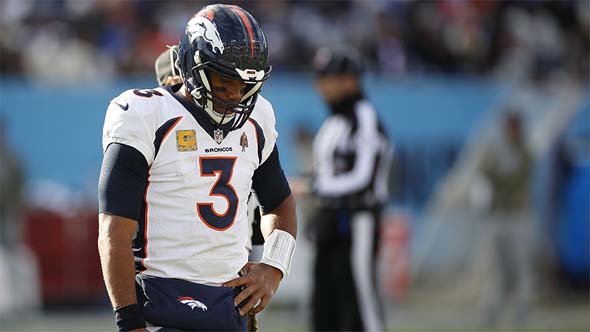 photo credit: Silas Walker / Getty Images
photo credit: Silas Walker / Getty Images
Will Russell Wilson bounce back after a miserable 2022 season with the Broncos?
I can't think of any better example of regression turning a star player into a complete mystery box than the case of Russel Wilson's performance with Denver in 2022. I was high on the Broncos after the Russel Wilson trade. Their situation reminded me a lot of the Stafford trade to the Rams the year prior. After the Wilson to Broncos trade, I ran out to the sportsbook and put money on the Broncos making the playoffs and going to the SuperBowl. Boy was I wrong.
How much of the Russel Wilson's poor 2022 season was the result of bad coaching, and how much of it was regression on Wilson? Hard to say. We know there was bad coaching. Hackett was fired midway through the season. Heck, he was so far out of his element that he had to hire an assistant coach to tell him when to call timeouts. But Russel's play also was not good. Was this just a bad year? Or was it a sign of permanent regression? Has Russel Wilson lost a step, and isn't the QB that we all thought he was? Or will he bounce back in 2023 and look like an elite quarterback again?
In Madden, the answer to this would be obvious. Just look at Wilson's rating.
How do other games handle this?
Let's contrast Madden's approach of giving absolute information to the user against how the indie football sim Axis Football handles player ratings. Axis Football does have numeric ratings for all player attributes on a 100-point scale, just like Madden does. However, you can only see these numbers by going into the roster editor. These numbers are not visible to the user EVER in the Franchise Mode. Instead, Axis Football gives letter grades for each player's attribute ratings. These letter grades encompass a small range of possible numeric values. Instead of simply telling you that a player has an 88 speed rating, Axis says he has a B+, but that B+ could mean anywhere from 87 to 89.
Thus, 2 (or more) players with the same overall rating (for example, a B+) could still be separated by several points on the 100-point scale, and the user doesn't necessarily know which player is actually the better player, even though the difference between them is actually fairly marginal. But this creates decisions for the user to make, and opens up new approaches for team-building and management.
Axis Football slightly obfuscates player ratings by showing grades instead of absolute numbers.
Both players being a B+ means that neither is the clear starter over the other, and their role on the team is going to depend on user strategy. I can pick the one whose specific ratings best suit my playstyle and play-calling. If I run a zone running scheme, maybe I start the faster running back because he's going to have an easier time beating defenders to the outside for big runs. If I run a power scheme, maybe I prefer the stronger back who is going to be able to run over defenders in the gap.
And I can also use these players in rotational roles. Axis doesn't have the convenient depth chart positions for passing-down backs or short-yardage backs like what Madden has, so I would have to manually sub in a player for that specific situation. If my power back is my main back, but the defense is loading the box for a goalline stand, maybe I sub in the quicker back to try to get him to the outside on a toss. And maybe I sub in a more agile back with better catching rating for 3rd down passing situations.
Yes, Madden allows the user to do all these things as well, but the decisions feel more automatic because Madden gives those absolute ratings. The starter is just the player with the highest overall rating for the given depth chart position. In Axis Football, the more ambiguous rating system forces me to make more judgement calls.
Similarly, when the offseason comes around, I have a more difficult decisions to make. Both my running backs are B+. Neither is a clear starter. So who do I re-sign, and who do I trade away or let go into free agency? I don't have an absolute number telling me that one back is 2 points better than the other. I have to make a judgement call. That judgement call will likely come down to which of the 2 played better for me.
And then there's Backbreaker. Backbreaker, sadly, did not turn out to be the revolutionary football game that it promised to be. But it did have some clever ideas. In fact, I've already referred to Backbreaker once or twice in previous installments of this series. Backbreaker's Career Mode was pretty bare-bones, but it did have one interesting idea.
Players in Backbreaker could be in good or bad "form" in any given weak, impacting their on-field performance.
Backbreaker had the "form" mechanic. Basically, players could have good or bad weeks of practice, which would carry over and translate into improved or nerfed performance (respectively) in that week's matchup. You still knew what each player's true ratings were, but you had to make a judgement call on whether to stick with your regular, higher-rated starter who maybe had an average or bad week of practice; versus giving more playing time to a younger, lower-rated backup who might have had a really good week of practice.
Maybe Madden could adapt this idea, and add it to its own weekly practice mechanic. How well a player performs in practice could depend on various factors, such as a consistency rating or trait, how many reps they are given in practice, their morale, progressive fatigue levels, certain personality traits or motivations, and so forth.
More about strategy, yet to come?
This was a big topic and a lengthy essay. Thanks for sticking with it. I really hope everyone enjoyed it, and I really hope that some football game developer somewhere, whether it's EA, 2K, Axis, Modus, Super Pixel, or someone else, takes this idea seriously and tries it out. It's a shame that it was partially implemented in Madden 12 and then just abandoned and forgotten.
I had actually initially planned on doing stand-alone essays for each for the preseason and draft, but I really feel like this just about covers it all -- at least the important stuff. Also, who knows how long the preseason will be around, so it might be a moot topic anyway... I might have more to say about the draft in the future. We'll see. For now, I think I want to stick to football strategy for the next topic or 2. Specifically, I think I might talk about the lackluster efforts that Madden and other football games have taken towards game-planning and in-game strategy. So stay tuned!